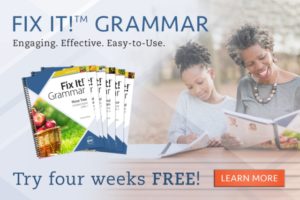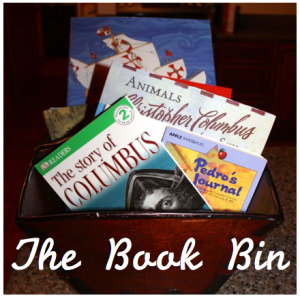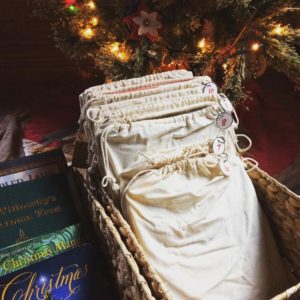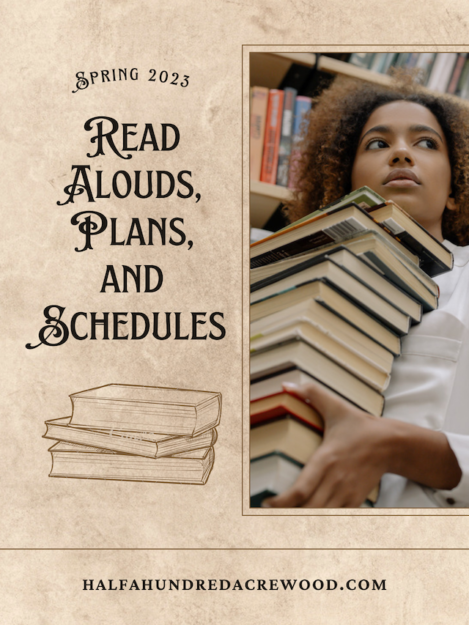
Teach us to number our days, that we may gain a heart of wisdom. Psalm 90:12, NIV
I tend to approach this time of year with caution. While part of numbering our days aright is planning well, part of numbering our days aright is letting go of those plans when God has something else in store for our family.
So before we get started here, we acknowledge that the January and February winter months hold great potential for disrupting the ideal. This time of year (or any time of year), it’s okay to rethink goals. It’s okay to set aside curriculum. It’s okay to slow the pace. It’s okay to take time to enjoy family. It’s not just okay, it’s necessary.
Homeschooling is about relationships, not curriculum. It’s about our relationship with God, our relationship with each other, and our relationship to the world around us. If we seek first the kingdom of God, all of the other things will fall into place. With that in mind, we share our homeschool plans for the spring semester.
In a nutshell, what does it look like?
- Family Morning Time (encompasses read-alouds, history, science, geography, scripture, and fine arts)
- Individual Math for Each Student
- Individual Language Arts & Assigned Literature for Each Student
- Latin & Logic for Middle School
- Required Electives for High School
Because our family morning time covers so much ground in an efficient/effective manner (40-60 minutes total most days), it simplifies our overall schedule, especially for elementary and middle school. So… let’s just start with family read-alouds and morning time. Then we’ll highlight curriculum choices at each level and an example schedule.
Our Read Aloud Selections for Second Semester:
We’ve studied history, religion, cultures, and geography through inspiring true stories of missionaries, and I can’t tell you how much it has impacted us! We’re repeating all of the stories we read three years ago while also adding a couple of new ones. (They are all so great that we can’t wait to re-read them!) This collection of biographies provides a glimpse of how God has used willing vessels to extend love and compassion through a dark time in world history.








Our family read-alouds are taken from the Mission: Faith Forgers lesson plans. You can download a sample to see how it’s scheduled out here. Repeats include:
- George Müller: The Guardian of Bristol’s Orphans (Industrial Age). George Muller opened his life up to caring for the orphans of Bristol during the Industrial Age. Amazing story of faith in action!
- Eric Liddell: Something Greater Than Gold (World War I through World War II). Known for standing on his convictions to honor God during the 1924 Summer Olympics, athlete Eric Liddell later devoted himself to sharing the Gospel as a missionary to China, serving in a Japanese internment camp during World War II.
- Corrie Ten Boom: Keeper of the Angel’s Den (World War II). During a time of great darkness, the ten Boom family risked their lives as they extended compassion to those under intense persecution during World War II. This true story of bravery, faith, and forgiveness remains a strong testimony of God’s power and grace. (We may replace this with The Hiding Place, which we’ve also read before.)
- Gladys Aylward: The Adventures of a Lifetime (World War II and Communism). One of the most amazing adventures of faith and endurance, Gladys Aylward’s story shows a life lived in trust and devotion to God as she ventures through communist Russia to follow God’s call to minister to the Chinese through World War II and beyond.
- Richard Wurmbrand: Love Your Enemies (World War II and Communism). Founder of Voice of the Martyrs, former atheist Richard Wurmbrand accepted Christ and His call to serve Him as a pastor in Romania as World War II gave way to Communism. Wurmbrand endured years of torture in prison for preaching the Gospel, yet responded with love towards his captors.
- God’s Smuggler (Young Reader’s Edition) (Communism). Riveting, powerful, and thought-provoking, Brother Andrew’s autobiography recounts his journey of faith as he smuggled Bibles into countries behind the Iron Curtain. This edition has been written for a younger audience and is a great read aloud for younger children. (We also highly recommend the original version for both teens and adults! It will give you much to think about and discuss!)
Our new read-alouds include:
- C.S. Lewis: Master Storyteller (World War I and beyond)
- Dietrich Bonhoeffer: In the Midst of Wickedness (World War II)
But why biographies? When my children face persecution, my desire is that they would remember two things: God’s Word (e.g., scriptures that remind them of God’s Truth) and the “cloud of witnesses” that have gone before them. By reading about the love that Richard Wurmbrand extended to his torturers, or the joy of Jacob Deshazer upon remembering the Japanese, or the surrender of Charles Mulli to open his home to the street children of Kenya, we can reflect upon tangible examples of how God has worked through and strengthened the faith of our brothers and sisters in Christ. We are also strengthened and encouraged as we walk out His purpose for our lives.
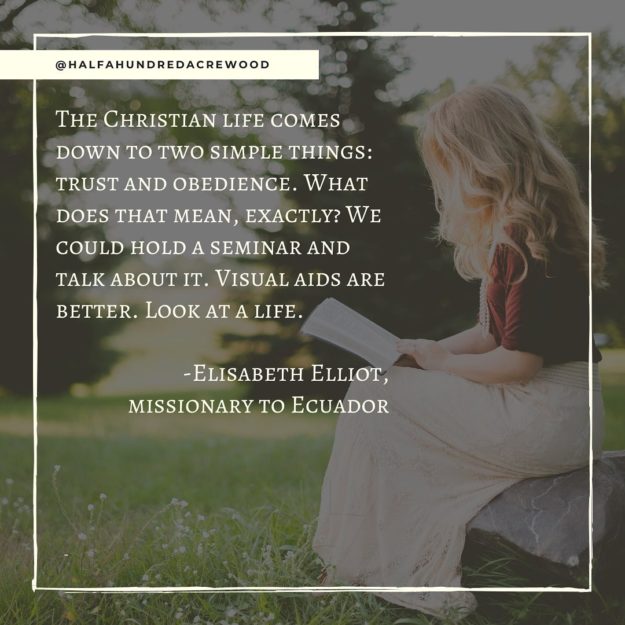
What does it mean to trust and obey? Look at a life. God empowered others. He will empower us.
Note: Our family listens to many audiobooks due to the amount of time we are in the car each week. To see a running list of everything we’ve read (during the calendar year 2022), click here.
Morning Time = Family Togetherness Time
For the past few years, we’ve explored the ongoing fulfillment of the Great Commission through this missions-focused curriculum that provides a complete three-year social studies and science program which integrates the study of scripture, history, geography, missions, hymns, orchestra study, and art projects using our favorite books for elementary through middle school. Not every day includes all of these subjects, but they’re scheduled/paced out in a simple format in the Mission: Faith Forgers Reading Plan. The framework of the program is built around ordinary people whom God used in extraordinary ways. It’s a foundation I wish I had experienced as a child, and it is one I am building now in my own heart alongside my children.
You can start this curriculum mid-year! Visit this post to find out how!
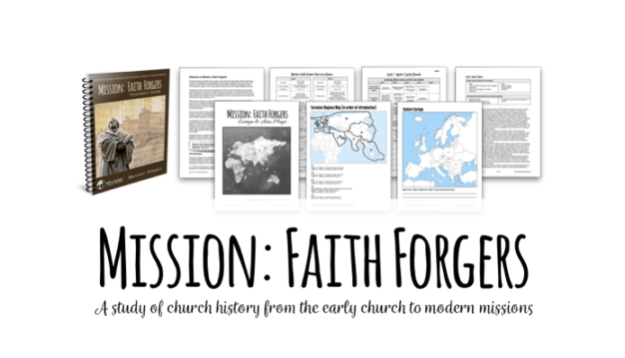 Morning time usually takes us about 45 minutes to complete, unless an art project or science experiment is scheduled. I provided some photos of science and art projects we completed first semester in our sneak peek into our homeschool! Below, we’ve also included a few reasons why we’ve picked each resource in Mission Faith Forgers below. The general plan for the remainder of the year is…
Morning time usually takes us about 45 minutes to complete, unless an art project or science experiment is scheduled. I provided some photos of science and art projects we completed first semester in our sneak peek into our homeschool! Below, we’ve also included a few reasons why we’ve picked each resource in Mission Faith Forgers below. The general plan for the remainder of the year is…
Bible. We begin our days with reading the Bible each morning and discussing as a family. This year, our Bible readings and devotions are related to world missions. This semester, we’ll be memorizing Matthew 6:9-13, Psalm 23, Matthew 5:3-9, and 1 Corinthian 13:4-13 using Bible Readeez.
Hymn Study. We’re studying hymns that correspond to the missionary or historical context using the book Then Sings My Soul.
Science. This semester, we’ll be using God’s Design for Physical Science: Machines & Motion for a simple study of mechanical forces, simple machines, kinematics, dynamics, motion (Newton’s laws), and machines throughout history. (I’m teaching this class to sixty students at our co-op!) We enjoy the God’s Design series because it is one of the simplest science programs to implement. It uses a hands-on approach to learning, the readings take less than 10 minutes, the experiments mostly use common household items, and the books include color illustrations and photos. Answers in Genesis stopped publishing the individual titles in 2021, so they are now only available as the triple-volume sets published by Masterbooks, which we now carry in our store.
Geography. We’ll continue memorizing all of the countries of Europe and Asia, along with some of the Eurasian continent’s physical features. Resources include Window on the World, the Usborne Geography Encyclopedia, Children’s Atlas of God’s World, and Geography Songs. These books are our favorite geography resources which we use over a two-year period to memorize the countries of the world, learn about world cultures, and pray for other people groups and nations.
Art & Music. We’ll continue with our missions-correlated art projects using the step-by-step art projects from the Mission Faith Forgers Guide. We’ll also continue with our study of composers and orchestra using A Child’s Introduction to the Orchestra. This semester, we’ll be introducing Brahms and Mahler while also learning about the percussion section, and we’ll review Wagner and Tchaikovsky along with the other sections of the orchestra that we covered last semester.
History. We finished Story of the World Volume 3 last semester, so we’ll be continuing with Story of the World Volume 4 this semester. Over our years of homeschooling, we’ve reviewed and/or used other history programs (including The Mystery of History, The World’s Story, From Adam to Us, and Diana Waring’s History Revealed) but we’ve kept returning to The Story of the World because of its narrative quality. It has not only been the best history for providing cultural stories from around the world, it is also one of the few programs that includes an audiobook option making it easier for homeschooling families to implement.
Download a sample of Mission Faith Forgers here and read reviews on our Testimonials page. For an overview and peek inside each of the resources in Mission Faith Forgers, check out this video!
Over the past four years, we’ve enjoyed connecting as a family in this unified learning experience each morning. This is our most special time, and our teenagers enjoy being a part of it. After that, our older students are fairly independent in their individual work and just ask questions as they need my assistance. After morning time, most of my day is spent on teaching reading, writing, and arithmetic (3rd grader), formal writing/editing (8th & 11th grader), and literature/history discussions (everyone).
Mid-Year Curriculum Update: Elementary through High School
I haven’t had a chance to put together a mid-year reality check, but here’s the lowdown on what we’re using this semester beyond Mission: Faith Forgers. A couple of things to note regarding all levels:
- Regarding Math. We switched everyone to Math U See in our home which has resulted in the best outcome of any option we have used in the past – for all of our children! Most math programs implement either too few math problems or too many. This program has a good balance, and it’s the only math course our three oldest sons have enjoyed. Also, starting Math U See PreAlgebra in 7th grade provides the opportunity to complete math through Calculus I in high school.
- Regarding Literature Discussion. Instead of using regular comprehension literature guides, our family’s literature discussions follow the Teaching the Classics Approach. (We highly recommend Teaching the Classics for parents to learn how to discuss literature with their children!) Students can fill out a story chart for each work of literature while also practicing the art of narration.
High School (Grade 11) – Curriculum & Literature Update
We’ve already mentioned why we chose the following curriculum selections in our curriculum choices post for this year, so I’ll just add any relevant changes or additions…
- Finishing Economics (1/2 credit). Our 11th grader didn’t quite finish preparing for the Economics CLEP exam because our schedule was interrupted with an urgent trip to be with family in Oklahoma. He loved trekking through Economics for Everybody, an engaging exploration of world economics. Because this course fits better with macroeconomics, he’s using a couple of resources to finish preparing for the Microeconomics CLEP test which will give him three hours of college credit. (His current chosen college degree path prefers credit in microeconomics.) We also decided to wait on Personal Finance so two brothers can work through it together next school year. Learn more about CLEP testing for college credit here.
- Physics (1 lab science credit) – Exploring Creation with Physics – 2nd Edition.
- English Composition (1 credit) – We’ve focused primarily on rhetoric (written speeches and oratory) this year as the practical application of all his previous years of instruction in composition. He’s using both Fitting Words (read our review here) and Rhetoric Alive!
- Math (1 credit) – Math U See Algebra 2.
- P.E. (1 credit) – Training for and running in 5K races in the coming year.
- Literature Selections.
- Choice of Charles Dickens (choosing from David Copperfield, Hard Times, Great Expectations, or Oliver Twist)
- Farenheit 451 by Ray Bradbury
- Amusing Ourselves to Death by Neil Postman
- How Should We Then Live by Francis Schaeffer
- Shadow of the Almighty: The Life and Testament of Jim Elliot by Elisabeth Elliot
Here’s a snippet of two weeks of his lesson plans towards the middle of this semester:
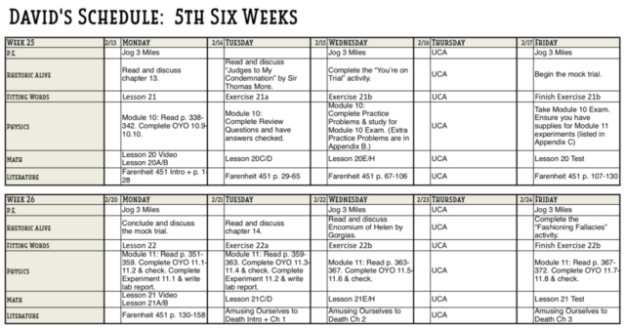
Note: “UCA” is the name of our weekly co-op where he takes elective classes in art and Bible.
Middle School (Grade 8) – Curriculum & Literature
Our eighth grader’s science, fine arts, geography, and history work are taken primarily from Mission: Faith Forgers. Other subjects we incorporate at this level are Latin, Logic, English Composition, and Math.
- Family Morning Time – Mission Faith Forgers (history, church history, world geography, physical science, art, orchestra).
- Latin/Grammar/Vocabulary – Visual Latin II. (Read more about why we love Visual Latin here.) Our third son will complete his Latin studies this year during middle school before heading into Spanish in high school. He has wanted to work in construction since age 2, so Spanish Grammar from Latin Roots will be his high school level foreign language.
- Logic – Introductory Logic.
- English Composition – Modern World History-Based Writing Lessons. This overlaps the history in Mission Faith Forgers with source texts on topics such as inventions of the Industrial Age, Wilson (World War I), Churchill (World War II), Sherlock Holmes, communism, and stories from modern world cultures. Also, because it’s the best {easiest, quickest, most effective} way to hone mechanics and editing skills, he will continue to use Fix It Grammar Level 3: Robin Hood. (Read more about why we love this program so much!)
- Math – Math U See Algebra I.
- Memory Work. Linguistic Development through Poetry Memorization. Try it free here!
- Literature Selections. Our middle-schooler’s literature selections correspond roughly to history assigned in Mission: Faith Forgers:
- The Secret Garden by Frances Hodgson Burnett
- Angel on the Square by Gloria Whelan
- Boy on the Wooden Box by Leon Leyson
- Children of the Storm by Natasha Vins
- Do Hard Things by Alex & Brett Harris
Here’s a snippet of two weeks of his lesson plans towards the middle of this semester:
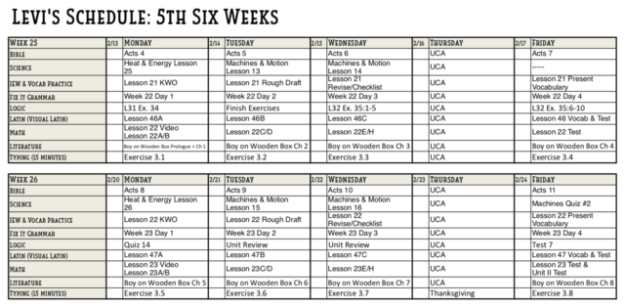
Elementary School (Grade 3) – Curriculum & Literature
- Family Morning Time – Mission Faith Forgers (history, church history, world geography, physical science, art, orchestra – all mentioned above). He’ll memorize all the countries of Europe and Asia this year!
- Memory Work. Linguistic Development through Poetry Memorization. Try it free here!
- Math. Math U See Gamma.
- Reading & Spelling. All About Reading Level 4. He was enjoying his lessons so much that we finished Level 3 last semester. (Click here to read our thoughts on this program.) For spelling instruction, we decided to review All About Spelling Level 2 (instead of continuing with Level 3).
- Penmanship. Script-n-Scribe Hymns in History (which reinforces the hymns and history through the 20th century and automatically incorporates picture study and application of grammar concepts).
- Composition. IEW Bible Heroes Writing Lessons – Includes free Teacher Edition ebook.
- Grammar. Level 1: Nose Tree. Short, simple lessons for reinforcing mechanics and editing skills over the course of the year. This is the quickest, most effective way to apply English grammar and mechanics. Read the reasons we love this program so much!
- Literature Selections. For our 3rd grader, we’ll be reading select titles from these favorite middle-ages-to-modern-times picture books and leveled readers using the “book bin” approach. We’ll also embark on some shared reading using the following shorter chapter books:
- His choice of Stepping Stone Classics: The Three Musketeers, Les Miserables, Great Expectations, or Oliver Twist
- The Little Riders by Margaretha Shemin
- Twenty and Ten by Claire Hutchet Bishop
Here’s a snippet of two weeks of his lesson plans towards the middle of this semester:
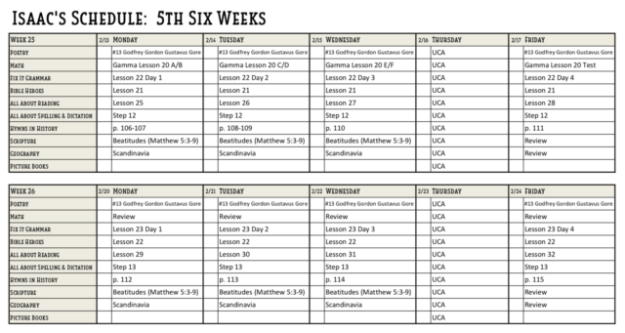
The Book Bin Approach: At the beginning of each week, fill a basket full of the books that you’re planning to read that week. For greater anticipation, you can store them in bags as we do for our Christmas book countdown!
Sample Homeschool Schedules
I’ll wrap this up by including a sample schedule. Our actual schedule deviates from this quite a bit. Usually, one child is working on math while I’m working with another on language arts. If I’m working with a sibling, they know to work through their assignments and simply highlight/circle anything with which they need my help. That’s why a checklist/schedule is so helpful for all of us. I have one printed for each one of them!
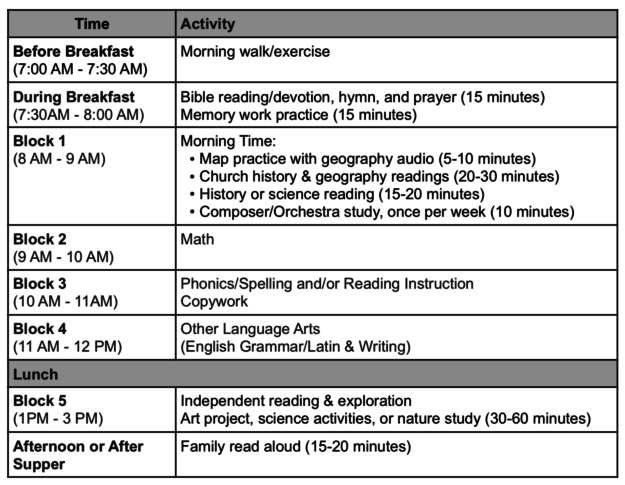
Rest assured that a schedule looks more orderly on paper than it does in real life! We’re not always up by 7:30 AM. In the past, I’ve juggled four different students studying many different subjects. By the end of the day, though, each child has completed all of his daily assignments. It helps that each student knows what the schedule is supposed to be, and they all work fairly well using that checklist. Here’s a more simplistic format of what our core, bare-bones schedule sort of looks like (but for us, Block 1 consists of our Mission Faith Forgers Morning Time instead of just Memory work and maps).

If you have any questions about this schedule, about any of our curriculum choices or literature selections, or about homeschool planning in general, feel free to give us a shout!
As we head into a new semester remember that “God is faithful, more than capable to be faithful to the end – and finish what he started.” – MercyMe

